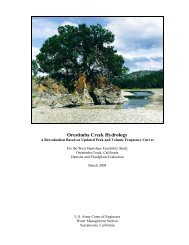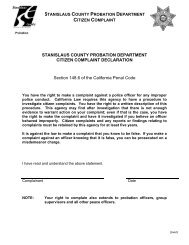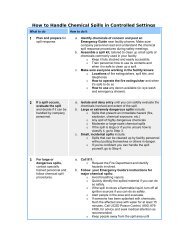Orestimba Creek Feasibility Study - Stanislaus County
Orestimba Creek Feasibility Study - Stanislaus County
Orestimba Creek Feasibility Study - Stanislaus County
You also want an ePaper? Increase the reach of your titles
YUMPU automatically turns print PDFs into web optimized ePapers that Google loves.
Economics Appendix – Draft Report - <strong>Orestimba</strong> <strong>Creek</strong> <strong>Feasibility</strong> <strong>Study</strong>, <strong>Stanislaus</strong> <strong>County</strong>, California – September 2012<br />
Considering a 1% event flood, shallow inundation is expected to occur on the west side of<br />
highway 33 in the northern area of Newman. Due to the shallow nature of flooding and the<br />
warning time allotted for the event it is expected that most, if not all, residents residing in the<br />
area would have adequate time to evacuate. Businesses along the west side of highway 33 would<br />
also have time to brace for the shallow flood.<br />
With the project in place the 66 residents in nursing homes in Newman would have a relatively<br />
low risk of seeing flood waters in the northern area of the City. However, due to the<br />
consequences, should a break in the level occur, it is deemed prudent to have emergency staff on<br />
hand during the flood event to transport the nursing home residents, if necessary.<br />
The With Project Alternative does not address rural roads that are subject to flooding.<br />
Discussions with local law enforcement and <strong>County</strong> officials have indicated that there are<br />
proactive steps being taken to warn travelers of road closures. Crossing arms which are activated<br />
by rising water is creeks have been installed to halt travelers from entering into hazardous<br />
crossings.<br />
Reconstruction efforts are expected to be minimal under the “with project” condition within the<br />
confines of Newman. The majority of the damages are expected to be incurred by business<br />
along highway 33.<br />
Environmental Justice<br />
Executive Order 12898 concerning environmental justice provides direction on the analysis of<br />
social and economic effects that would be applicable to the proposed flood risk management<br />
project. On February 11, 1994, President Clinton signed EO 12898, Federal Actions to Address<br />
Environmental Justice in Minority and Low-Income Populations. It requires that environmental<br />
analyses of proposed Federal actions address any disproportionately high and adverse human<br />
health or environmental effects on minority and low-income communities. Federal agencies’<br />
responsibility under this order also applies equally to Native American programs. In addition,<br />
each Federal agency must ensure that public documents, notices, and hearings are readily<br />
accessible to the public.<br />
In April 1997, President Clinton signed Executive Order EO 13045, Protection of Children from<br />
Environmental Health Risks and Safety Risks. This EO requires Federal agencies to identify,<br />
assess, and address disproportionate environmental health and safety risks to children from<br />
Federal actions.<br />
According to CEQ and EPA guidelines established to assist Federal and State agencies in<br />
examining the potential for environmental justice impacts, the first step in conducting an<br />
environmental justice analysis is to define minority and low-income populations. Based on these<br />
guidelines, a minority population is present in a project study area if:<br />
• The minority population of the affected area exceeds 50 percent, or<br />
107
















